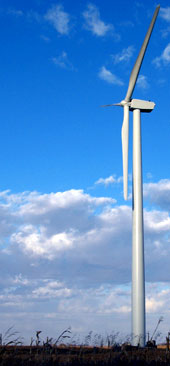AMES, Iowa -- James McCalley likens the task ahead to a major machinery rebuild.
You're starting with working equipment full of expensive parts. So you don't want to throw everything away and start over. You want to put together just the right combination of existing parts and new pieces to make the most cost-effective, sustainable and resilient machine possible.
In this case, the machine is the country's energy and transportation infrastructure.
McCalley, Iowa State University's Murray J. and Ruth Harpole Professor in Electrical and Computer Engineering, is leading a research team that will develop new and better infrastructure designs for the country's energy and transportation systems. They'll do that by developing computer models of the country's and the state's energy and transportation systems. They'll use the models to help develop a 40-year national plan to optimize those systems in terms of future power technologies, energy transport and storage, and hybrid power systems while balancing cost, sustainability and resiliency.
The project -- called "NETSCORE-21," "The 21st Century National Energy and Transportation Infrastructures Balancing Sustainability, Costs, and Resiliency Research Project" -- is supported by a four-year, $1.98 million grant from the National Science Foundation.
The project's research team will consider all of America's energy options, including biofuels, wind, hydro, tidal, geothermal, nuclear, coal, hydrogen, solar, biomass, natural gas and petroleum, together with new and old freight and passenger transportation technologies.
"Our intent is to say, 'We don't think there's a single silver bullet here,'" McCalley said. "We need all of these. What we need to decide is how much of each and when."
The Iowa State research team working to advance those decisions includes Arun Somani, Distinguished Professor, department chair and Jerry R. Junkins Chair in Electrical and Computer Engineering; Dionysios Aliprantis, an assistant professor of electrical and computer engineering; Lizhi Wang, an assistant professor of industrial and manufacturing systems engineering; Konstantina Gkritza, an assistant professor of civil, construction and environmental engineering; and Robert C. Brown, the Gary and Donna Hoover Chair in Mechanical Engineering, Anson Marston Distinguished Professor in Engineering and Iowa Farm Bureau director of Iowa State's Bioeconomy Institute. The project will also include more than 50 Iowa State students and 22 project advisors from across the country.
"We looked around and said, 'Who's looking at national energy and transportation infrastructures from a systematic view?'" McCalley said. "There are not many models out there."
The model created by the Iowa State researchers will highlight the growing interdependencies of the country's energy and transportation systems.
"The country's most heavy users of energy are the electric and transportation systems," McCalley said. "Now with hybrid-electric vehicles and hybrid-electric trains, these two historically independent energy systems are gradually coming together."
The NETSCORE-21 project is designed to help leaders understand the implications of the new technologies and new interdependencies.
McCalley said the research could provide Congress, the U.S. Department of Energy, the Environmental Protection Agency, industries and other decision makers with a national blueprint for better energy and transportation infrastructures. And that could help drive federal policy, research and investment over the next 40 years.
